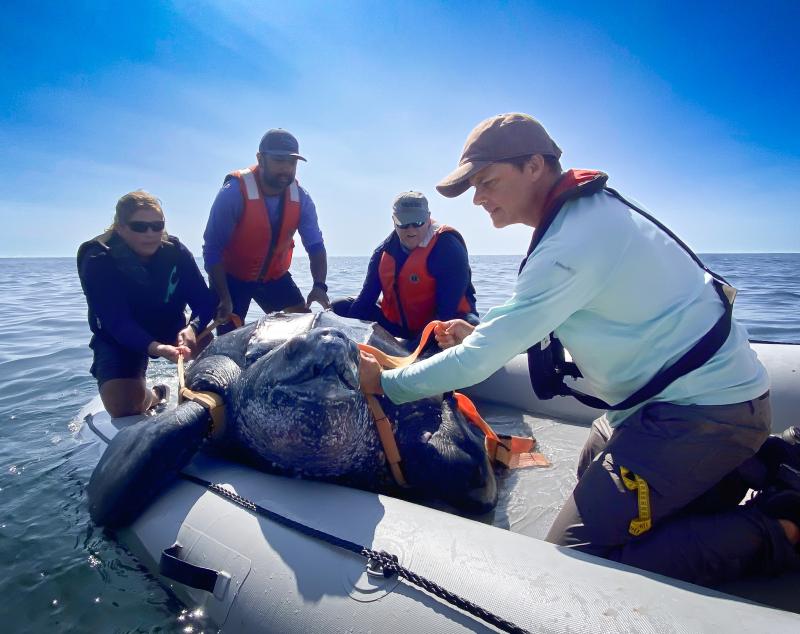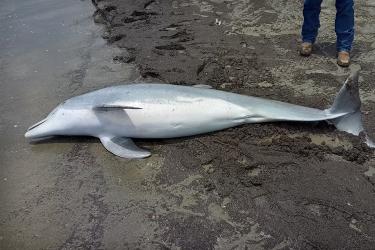Leatherback sea turtles are known to travel thousands of miles to move from warm, tropical and subtropical nesting areas to cooler, prey-rich feeding grounds. These locations—and the journey between them—are critical for supporting this species’ survival. New research has confirmed important foraging grounds along the Atlantic migration corridor for these aquatic giants.
Leatherbacks commonly swim from the South and Mid-Atlantic Bights during the warmer months to feeding areas near New England and Nova Scotia, Canada, where food is plentiful. They migrate southward again when water temperatures drop during the winter. But scientists didn’t know where the turtles went in between, and what they were doing along the way.
A team of researchers, including NOAA Fisheries and partners, set out on a quest to find out more about their movement patterns. Between 2017 and 2022, the team successfully tracked 52 leatherback sea turtles using satellite tags that also recorded location, depth, and temperature data. The team attached the tags to turtles off the coasts of Massachusetts and North Carolina. The tagging may seem like the easy part, but applying tags involves finding and capturing the several-hundred-pound turtles in their offshore environment—a very challenging task! The tags allow scientists to not just track where the turtles go, but the behaviors they exhibit during these migrations.
The paper, published in Frontiers in Marine Science, describes models and techniques used to provide information on habitat connectivity. This study provides insights into what occurs after the turtles are tagged, such as dive duration and frequency, use of the water column, and depth-temperature profiles and behavior. The research was led by the University of Miami Rosenstiel School of Marine, Atmospheric and Earth Science and NOAA Southeast Fisheries Science Center.
Stopping for Snacks?
The behavior and movement of many animals tend to be food-driven. This study indicates that’s the case for leatherbacks as well.
Many of the tagged turtles exhibited feeding behavior in southern New England in the late summer and early fall as expected. This coincided with a high abundance of jellyfish—the main prey for leatherbacks.
Fun fact: Leatherback turtle prey include sea nettles, lion’s mane jellyfish, and cannonball jellyfish!
The team also recorded evidence of feeding in the Mid-Atlantic Bight, offshore of Delaware Bay and Barnegat Bay in New Jersey that occurred around the time that high concentrations of sea nettles (one of the turtles’ favorite foods) were recorded. They also tracked feeding behavior in Long Island Sound for the first time. This only happened in one year of the study, but likely coincided with a bloom of lion’s mane jellyfish—another common prey item for leatherbacks. These findings suggest that both the Mid- and South Atlantic Bights are critical, but underappreciated, foraging areas for leatherbacks.
“We were really excited to find evidence that the Mid-Atlantic Bight serves as a major foraging ground for leatherbacks migrating along the continental shelf, said Dr. Chris Sasso, principal investigator on the study. “We knew the turtles migrate through this area, but with these depth-logging satellite tags we were able to track more fine-scale behaviors to see what they were actually doing—basically stopping for snacks along the way.”
To Migrate or Not to Migrate?
While most of the leatherbacks migrated as expected, there were a few exceptions. A couple of males caused the team to scratch their heads a bit. Two of the males that were tagged traveled from the northern Atlantic foraging areas to subtropical waters over a couple of months immediately turned around, and traveled back.
Novel Movement Patterns by Male Leatherbacks
This behavior contradicts the prior suspicion that males migrate between northern foraging grounds and waters near nesting beaches for mating every year. Similar findings in the Gulf of Mexico suggest that foraging males forego migration to nesting beaches in some years and continue feeding during the winter along the West Florida continental shelf.
“We previously thought that males returned to nesting beaches each year, since they may not require the same energy budget as females who take 2–3 years to return,” said Mitch Rider, lead author of the study. “Our data show that several males spend the winter elsewhere—suggesting the opposite. This is important information as this will impact estimations of adult sex ratios and subsequent population dynamic models for each nesting population.”
These data provide the baseline needed to begin to understand and predict potential impacts of climate change on leatherbacks in the region. A more thorough understanding of how and why leatherbacks select their foraging areas, and the impacts of threats, will allow for better management of this endangered species.
Future Research
We still need more detailed information to better understand how leatherbacks use their environment and the threats in their path. In the future, the team plans to attach cameras to the animals to observe behaviors more directly.
The data collected in this study should serve as a baseline when comparing additional leatherback foraging and migration behaviors in a changing ocean. Managers conserving and recovering leatherbacks should consider these data when evaluating the potential effects of human activities in the marine environment.
Big Effort for Big Animals
Research on this wide geographic scale, and with such large animals, is quite the undertaking. This project could not have been done without:
- University of Miami Rosenstiel School of Marine and Atmospheric Science
- NOAA Northeast Fisheries Science Center
- Coonamessett Farm Foundation
- NOAA Aircraft Operations Center
- Twin Otter Crew
- Crew of the Warren Jr. and Semper Offshore
- Anthem Commercial Air Services
Science-Based Protection for Leatherbacks
Leatherback turtles are protected under the Endangered Species Act and listed as endangered. NOAA Fisheries is working to protect and recover this species in many ways, to conserve and recover the species worldwide. We continue to research the biology, behavior, and ecology of leatherback sea turtles to inform management decisions and enhance recovery efforts for the species.
All research was conducted under Permits #16733 and #21233 and approved by the NOAA Fisheries Atlantic Institutional Animal Care and Use Committee.





